Home » Construction Services
Category Archives: Construction Services
Finding The Right Desktop Computer: Tips And Tricks
Computers have been around for a short time, but they’ve had a huge impact on our lives. We all need to have one in our homes today, whether it is for surfing the internet, connecting with family, doing homework or working from home. Buying the best will be easy once you complete reading this article.
Look at what is included for the servicing of your desktop computer. Check to see if there will be onsite service, or a technician that arrives at your location to do repairs for the duration of your warranty. Find out what you get if onsite is not offered, along with how long. Check to see if your machine can be serviced at a local service center. Also, look at the time frames for replacements, repairs, and if you receive a loaned computer in case the time frame is unacceptable.
A good way to decide what features you want in a new computer is to try out different models before you buy. Many stores have a large selection of models set up and it is a wise idea to spend some time trying them out. You can see which keyboard is most comfortable and which screen size is right for your needs.
When choosing a desktop computer take into consideration what you will be using it for. If you will simply be using it for web access and word processing, then you can afford to go cheaper. If you will be gaming you’ll want a graphics card, and more RAM. The task you’ll be using it for will be important in deciding your price point.
Taking the time to read all of this expert advice will change your future for the better. You’ll have no problems as you search out a desktop computer to suit your needs. Share this article with your loved ones so that they can also buy a great computer in the future.
You can also visit our other websites and post your article.
Great Northern Carving, A1 Bathroom 4U, Trees For Education, RDRY Wall Taping, Conwy Trees, Lab Home Now, 1886 Investments, Near Impact, Fort Sill Apache Nation, Jr Custom Built, Graphic Accounts, Zazen Gallery, HVAC Tab, Torto Wheaton, Files To Burn, AJ Pietig, ,Concrete, Keith Raniere Conversations, The Fish Oil Zone, Pool Deluxe, Motor Ama Assoc, Main Street Resources, Search Engine Semseo, Digital Delusion, Bryan Mc Quade, Perthmet, Cots Wold Internet, TWF Internet, Spirit Light Out Reach, YQB Name, Hambys Chapel, Performance Lifestyle Advisor , Ocean Leroy, The Herrick Lodge , Debbies Painted Pets, Tobyn Ross Photography Google Translates,
Hiring a Professional for Tile Roofing Installation and Repair
Tile roofing is an excellent choice for any home. It’s a durable material that has a traditional history dating back to ancient times. While traditional roof tiles are usually made from slate or terracotta, modern materials can also be used. For example, some clay tiles have waterproof glazes that help keep rain and snow off of the building. And since it’s an excellent way to protect a house from the elements, it’s an excellent option for many types of roofs.

Roofing professional is the best option to clean and maintain your tile roofing. This way, you’ll avoid costly repairs or premature replacement. In addition to keeping a tile roof looking beautiful, it will last longer. It’s also better for your budget than to ignore small leaks and stains. In addition, if you notice cracks or chips on the tiles, you can easily replace them so that the damage won’t spread. Finally, having a tile roof is a good option because it can stand up to the elements.
The only drawback of tile roofing is its maintenance. If you’re not a handy person, you’re at risk of breaking a tile roof. You may also have to replace the underlayment, which is a standard part of the process. And if your tile roofing company doesn’t use a durable material like PVC or rubber, you’ll end up with a more expensive roof than you thought you’d have to spend. But this is all worth it when you see the long-lasting benefits that come with a tile roof.
While you can choose any material for your roofing, you have to be sure you hire an experienced contractor to install it properly. A tile roof will last for many decades if installed by a professional. However, hiring an experienced roofing contractor is vital because improper installation can cause the tiles to break or fall. Therefore, if you want your tile roofing to last as long as possible, you should contact an experienced roofer. Then, if you choose a tile roof, you can be sure that you’re making the right decision for your home.
You can find tile roofing contractors in your area using the Better Homes & Gardens local services website. These professionals can install a tile roof properly. First, they have to complete a training course that lasts a day. Then they’ll get the job done. To do this, you’ll need to ensure that the contractor you choose is certified for this type of roof. If you’re doing it yourself, you’ll need to ensure that your local laws comply.
In addition to being durable, tile roofing is also easy to install. Once you’ve completed the installation, it should last at least 50 years. You should also have a professional install the underlayment. The underlayment is the layer that provides additional protection against water damage. You should call a company with these services to learn more about the best tile roofing solutions for your home. There are several benefits to installing a tile roof on your home.
The cost of tile roofing will depend on its complexity and the region you’re in. Depending on the size of your roof, a new roof can cost anywhere from $8,500 to $30,000. The average tile roof contains 17 squares and costs anywhere from $5 to $18 per square foot. This means that a new tile roof can cover 1,700 square feet of space. But, because it’s a durable material, it will last for decades.
Despite their unique look, tile roofs are an excellent choice for homeowners who want a durable roof to protect them from weather and insects. They’re also an excellent option for those who want to add value to their home and make it more appealing to the eye. But, it’s important to note that tile roofing is not as durable as other types of roofing. So, you’ll need to consult a local roofing professional to determine which one will work best for you.
Despite its durability and resiliency, tile roofing is the most expensive material to purchase and install. However, a well-maintained tile roof can last up to 100 years if properly maintained. Unlike shingle roofs, tile roofs will last for decades if properly maintained. And, the most common cause of premature failure of a tile roof is poor maintenance. Broken or cracked tiles will allow water to run on the emergency underlayment.
Loftness debuts Battle Ax H Series mulcher for skid steers, CTLs, tractors
Today’s skid steers and compact track loaders crank out lots of hydraulic horsepower, and Loftness is taking advantage of that with its new Battle Ax H Series mulching attachments.
Designed for machines with 33 to 62.9 gallons per minute and 50 to 150 hydraulic horsepower, these heavy-duty models chew up the brush with an 88-inch cutting width. The H series has a V-drive variable displacement piston motor that automatically shifts the rotor rpm from high to low for increased torque as needed. The result is less stalling and a shorter recovery time, which allows you to concentrate on the work instead of the power settings and repositioning the head.
A two-stage cutting chamber processes material thoroughly, and the primary shear bar is adjustable for controlling particle size. Other standard features include a synchronous belt drive, bearing anti-wrap protection, adjustable skid shoes and an on-board pressure gauge. Options include hydraulic or manual adjusting push bars, custom mounts and universal skid steer mounts, a hydraulic or manually adjustable tree pusher bar, and a trap door to help prevent the attachment from throwing material underneath the tractor.
The Battle Ax models feature a rotor with built-in depth gauges that function like the raker on a chain saw, preventing the cutting teeth from engaging too much material at one time. The mulchers can be used with reversible planer knives, hard-surfaced planer knives or double-edged carbide teeth. Single-bolt mounting allows the blades to be reversed or replaced on the jobsite with a hex socket and wrench.
And if you don’t have a skid steer or CTL, Loftness also introduced a new Battle Ax attachment for compact tractors. Designed for tractors with a 540 rpm PTO and 36 to 70 PTO horsepower, the PTO Battle Ax has a 61-inch cutting width and comes with a Category I hitch, but is adaptable to Category II, free-link or quick hitch.

Loftness Battle Ax attachment for tractors with PTOs.Loftness
Did you miss our previous article…
https://www.tortowheaton.com/?p=559
The Importance of Having an Emergency Towing Arrangement
Emergency towing is basically when a car is towed temporarily to an auto repair shop, car repair place, or some other convenient location for safekeeping until an authorized driver or owner can come out on-site to take care of the vehicle. Road accidents do occur, and they happen more often than you probably think. There is an estimated six thousand road accident-related fatalities each year. Therefore, there are several reasons why it is essential to call Azteca Towingtruck company if you have a flat tire or if you need a tire change.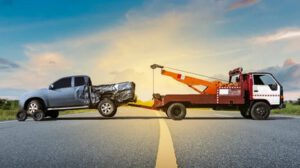
There are three standard emergency towing procedures. First, the tow truck will call 911 right away. The crew must then assess whether the vehicle can be towed without damaging the car or other property. If the damage is not too severe, the tow truck will file an emergency report with the local police. Next, the tow truck will inform the vessel’s master and the insurance company.
For larger vehicles, such as passenger cars, vans, or SUVs, the master will direct them to the nearest emergency towing service. Depending on how long the vehicle has been stranded on the road, the vehicle may need emergency towing services for at least twenty-four hours. Vehicles may need emergency towing service even longer if their batteries have failed and the engine has run out of gas.
The crew will also check for mechanical problems that could be the cause of the flat tire. It is important to note that emergency towing means different things to different people. For some people, it means only being able to safely get the vehicle to a nearby location. Other people may use emergency towing means to seek medical assistance during a roadside emergency. It is also possible for emergency towing services to provide emergency medical services in some circumstances.
In some cases, the tow truck driver may choose to call for an additional tow truck just to have two in the fleet. In order to make an emergency towing arrangement, the master of the vehicle and the second tow truck driver must meet. The agreement must include specific time limits so both will agree on the best time to make the pick-up gear changes. The time limits are usually thirty minutes to one hour.
There are a few requirements for this type of towing service. The first requirement is that a properly functioning emergency towing system is in place. Emergency towing requires a working engine, battery, alternator, spare tire, and sufficient fuel for the entire duration of the tow. Furthermore, a properly functioning tow rope is required. In the event of a flat, a tow rope that is attached to the rear bumper on a powerboat is recommended.
The second requirement is that the boat’s transom and bow area must be clear of obstructions. A strong point in the bows area is used as an anchor when a trailer is being used as well as when making the turn into the lake. This strong point, also called a tacking point, allows the tug to turn safely and not hit anything. Additionally, the tacking point ensures that the vessel will be balanced when it makes the turn. When the tow rope is attached to the second tow truck, this point is also used as an anchor.
In some situations, towing arrangements must be made when there is no strong point in the area that the vessel would use for an anchor. In these situations, the tug must make the best judgment call in order to make sure the right course of action is taken. In these situations, a professional technician must review the vessel and make any necessary adjustments. A professional technician is also capable of making alternative towing arrangements if another option is warranted. When there is no strong point in the area, there are many different types of towing equipment available. These options can include, but are not limited to, ski gear, ski lift, and a skipper.
Curry Supply Offers Keystone Service Bodies to Fit Contractors’ Sweet Spot

Curry Supply is introducing a new line of service truck bodies: Keystone and Keystone Pro. The Pro version features a crane body, and both models are built using light-weight, high-strength aluminum.
The crane tower on the Keystone Pro can handle up to a 25,000-foot-pound crane, while still providing compartment space for tool and equipment storage. Custom features and upgrades will be available on both Keystone builds, with work-ready stock trucks ready to ship nationwide beginning in the fourth quarter of 2021. Options include tool drawers and bolt bins, e-track, lube equipment, welder/generators, air compressors and multiple crane models.
Keystone bodies feature a 52-inch-wide and 129-inch-deep bed, with tie-down rings and a textured, slip-resistant floor for added safety. Each side features four compartments, three vertical and one horizontal, with at least 20 inches of depth and adjustable shelving. Protected door seals and stainless-steel rotary latches ensure compartments stay secure and watertight.
“Curry Supply’s introduction of the Keystone line of service bodies will fill a void in the mobile service truck market that we have experienced for quite some time,” says Jeff Shaw, company vice president of sales and marketing.
“Service trucks typically fall on the polar ends of both price and durability. You either have a robust, heavy-duty offering with tons of added content, or a light-duty offering that struggles to keep up in severe-duty environments and doesn’t accept application-specific modifications well. To find the middle ground, buyers are typically left to add light-duty options to an over-built body, or “heavier” options to a body that wasn’t designed to handle it.”
The objective at Keystone was to design a product optimized to hold up well in severe-duty environments and accept application-specific modifications at a lower price than most heavy-duty products, says Shaw. This resulted in features such as reinforced side packs with mounting rails to handle heavier accessories, robust doors, hinges, and weatherproofing.
“All of these address the common complaints contractors voice about light-duty service bodies,” says Shaw. “We reduced content by making crane reinforcement optional, and even still, we only engineered the reinforcements to some of the lighter duty electric/hydraulic cranes common to the applications this product was intended.”
The Keystone and Keystone Pro will be positioned alongside Curry Supply’s current offerings of Stellar, Autocrane, Reading, and Wilcox bodies.
Did you miss our previous article…
https://www.tortowheaton.com/?p=539
Nimble & Productive: Bobcat’s New L65 and L85 Compact Wheel Loaders
Compact wheel loaders continue to grow in popularity as contractors discover their many attributes: how they can dump higher, travel faster and turn tighter than skid steers and compact track loaders. And did we mention they do all this with a smaller engine and great fuel economy?
Bobcat’s latest entries into the compact wheel loader field include the L65 and L85 with standard bucket capacities of up to 1 cubic yard and a Z-bar front linkage. In addition to buckets and pallet forks, the new loaders hook up to a wide range of Bobcat tools and attachments using the powered Bob-Tach system.
The new loaders run on a redesigned Tier 4 Final Bobcat engine with improved cold-weather starting capability and components simplified for routine maintenance. The 2.4-liter turbocharged diesel engines put out 55 and 68 horsepower on the L65 and L85, respectively. The attachment control mode enables you to vary the engine and travel speeds separately to optimize auxiliary hydraulic performance.

Bobcat L85 compact wheel loaderDoosan BobcatA large fuel filter protects the engine from contamination and results in a longer filter life and increased holding capacity. The lift pump and self-priming fuel system offers continuous forced air outflow and eliminates the need for a primer bulb. And a pre-filter protects the lift pump from debris and particles that increase wear and degrade performance.
Articulated steering on the new L65 and L85 loaders delivers high maneuverability and a tight turning radius. The electronic hydrostatic transmission (E-HST) makes quick forward-reverse direction changes efficiently, increasing acceleration and delivering seamless speed control. The combination of the E-HST transmission and horsepower management automatically adjusts the loaders’ drive system to maximize pushing and loading power while minimizing the chance of stalling. Unlike other anti-stall systems, operators can maximize engine and drive torque on the L65 and L85 to match the demands of heavy lifting and digging.
Standard features include two-speed travel, differential lock, inching pedal, LED work lights, bucket level indicator and a 5-inch display with jog shuttle. Upgrade options include an attachment control device (seven pin connector), automatic ride control, enclosed cab with HVAC, rearview camera and a cloth suspension seat.
Quick Specs
Bobcat L65>
• Rated Operating Capacity with Bucket (Straight) 3,133 lb.
• Rated Operating Capacity with Bucket (Articulated) 2,618 lb.
• Rated Operating Capacity with Forks (Straight) 3,759 lb.
• Rated Operating Capacity with Forks (Articulated) 3,172 lb.
• Operating Weight 9,944 lb.
• Auxiliary Std Flow 19.8 gpm
Bobcat L85 >
• Rated Operating Capacity with Bucket (Straight) 3,974 lb.
• Rated Operating Capacity with Bucket (Articulated) 3,257 lb.
• Rated Operating Capacity with Forks (Straight) 4,786 lb.
• Rated Operating Capacity with Forks (Articulated) 3,977 lb.
• Operating Weight 11,164 lb.
• Auxiliary High Flow 27.34 gpm
The Future of Paving? Volvo Unveils Its CX01 Concept Compactor
Asphalt compactors aren’t known as the most difficult machine to operate on the job. Although compactors perform a critical function especially when smoothness specs are at stake, many contractors put their less-seasoned operators on them.
But what if these machines didn’t even require an on-board operator?
Enter Volvo Construction Equipment’s CX01 asphalt compaction concept, a planned ConExpo reveal that had to wait until the recent Utility Expo to get in front of contractors.
“We just wanted to examine what the future of compaction would look like,” Justin Zupanc, head of Volvo CE’s asphalt compaction development team, told Equipment World at the show. “We wanted to create a better operator’s environment, reduce fuel consumption and exhaust emissions and boost productivity.”
“Better operator environment” translates to no cab. Instead, a connected fleet of CX01 single-drum units directed by a downloaded compaction plan would be either be remotely controlled by an operator or controlled autonomously.
Volvo already has an autonomous system on its TA15 haulers, now in customer testing, and the plan is to test a similar system on the CX01, Zupanc says.
The CX01 does not have an articulation joint “so there’s no balance point, there’s nothing that we can steer away from,” Zupanc says. Volvo solved this by using a split-drum which has two halves that can be operated independently kept upright by using a self-balancing control system. (The split drum comes off of its current 9-ton class machine sold in Europe.) To turn, operators can vary the rate of speed of each half of the drum. “You can make a fairly tight turn,” he says.
And while it wouldn’t be used while the unit is on asphalt, users also would have the ability to pivot steer the machine.
Rethink the paving process
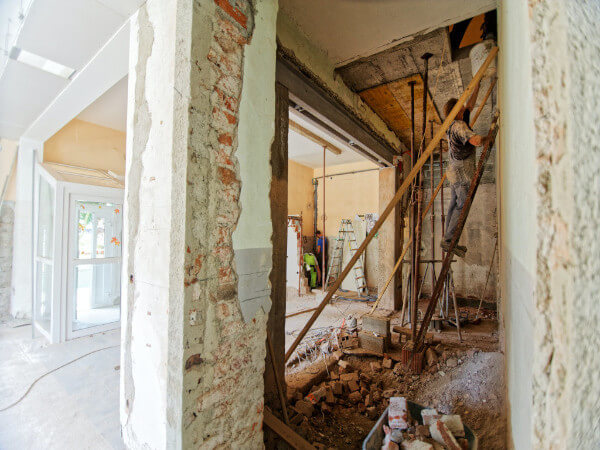
The Volvo CX01 prototype compactor features guarding and emergency stops on each corner.Equipment World
Volvo says the CX01 which stands for compaction experimental unit No. 1 provides the means to “fundamentally rethink the paving process.” By removing the operator, you’re also removing their exposure to vibration, noise and dust.
As envisioned, a fleet of CX01s could be deployed on larger jobs and communicate not only with each other but with other machines on site. The machines could survey the job, report on mat conditions such as density, temperature and passes (which intelligent compactors are already doing) and determine when and where to compact. “They can shift over if an area is already compacted,” Zupanc says. “All information is available to the crew and to other machines. You could even send it to the asphalt plant.”
The machine’s compact design and maneuverability could also lead to streamlined compaction cycles, reduced costs and more agile work patterns, Volvo says. The rolling pattern, weight and number of rollers could be adjusted to match the width, thickness and speed of the paving operation. Using Volvo’s existing Co-Pilot system, operators can use a touchscreen to remotely control the compactors.
Flexible power
The CX01 has a flexible power system. It has both a 1.7-liter diesel engine and an energy storage system that can be operated indiesel-only, hybrid or fully electric modes. “The diesel is only there to spin the 20-kilowatt generator,” Zupanc says. The generator in turn powers two 48-volt ultracapacitors placed on each side of the drum, which in turn are powering three 14-kilowatt electric motors, one for each side of the drum, and another to power the vibration system eccentrics.
“You can run it with the diesel engine on, and it’s always charging the ultracapacitors,” Zupanc says. When the ultracapacitors are charged, the engine can be turned off, and the machine becomes fully electric. The engine will cycle back on when the ultracapacitor charges get low. “They charge very quickly, within a couple of minutes,” he says. The downside: the capacitors don’t have the capacity of a lithium-ion battery; runtime is around 20 minutes, depending on your speed.
“We had never used them before, and we wanted to see how they worked,” Zupanc says, explaining why Volvo was using ultracapacitors on the CX01. “While they don’t have the capacity of lithium-ion batteries, they are good for vibration and they have a long lifecycle. They may not be the right solution because they don’t have that longevity, and who knows, we may couple them with a lithium-ion battery pack down the road.”
Because the ultracapacitors need a constant charge, it’s unlikely that the diesel engine will go away as long as they are used.
Volvo is also exploring using a low-friction water-reduction polymer-based coating on the drum surface now theoretical — which could also be used on its other compactors. This would combat the common problem of asphalt sticking to the drum, now solved by using water. The CX01, however, has limited water storage.
Volvo produced =the following explainer video of how it envisions the CX01 being used:
CMSBrowserComponents.load({ el: ‘#vue-1634590887297-229’, name: ‘OEmbed’, props: {“mountPoint”:”/__oembed”,”url”:”https://www.youtube.com/watch?v=NzC6q9GgT6o”,”attrs”:{“type”:”oembed”,”id”:”https://www.youtube.com/watch?v=NzC6q9GgT6o”,”element”:”aside”}}, hydrate: false });
Did you miss our previous article…
https://www.tortowheaton.com/?p=524
Report: One-Fourth of Infrastructure Faces Flood Risk. (Here’s How to Check Your Area’s Threat Level.)
A new report estimates that one-fourth of all critical infrastructure in the U.S. is at risk of flooding, and that percentage will increase as storms become more severe due to climate change.
The science and technology nonprofit First Street Foundation, in what it calls “the first ever nationwide community level flood resilience report,” says state and local governments are not equipped to handle the present and future flood risks to critical infrastructure.
“As we saw following the devastation of Hurricane Ida, our nation’s infrastructure is not built to a standard that protects against the level of flood risk we face today, let alone how those risks will grow over the next 30 years as the climate changes,” says Matthew Eby, founder and executive director of First Street Foundation.
The “Infrastructure on the Brink” report says that 25% of current “critical infrastructure,” such as utilities, airports, ports, and emergency services like police, fire and hospitals, is at risk of becoming inoperable due to flooding.
It estimates these other current infrastructure flood risks:
23% of all road segments in the country (nearly 2 million miles of road). 20% of all commercial properties (919,000).17% of all “social infrastructure” facilities (72,000). This includes such properties as schools and government buildings.14% of all residential properties (12.4 million).
The risks are expected to increase through 2051.
“Over the next 30 years, due to the impacts of climate change, an additional 1.2 million residential properties, 66,000 commercial properties, 63,000 miles of roads, 6,100 pieces of social infrastructure and 2,000 pieces of critical infrastructure will also have flood risk that would render them inoperable, inaccessible or impassable,” the report says.
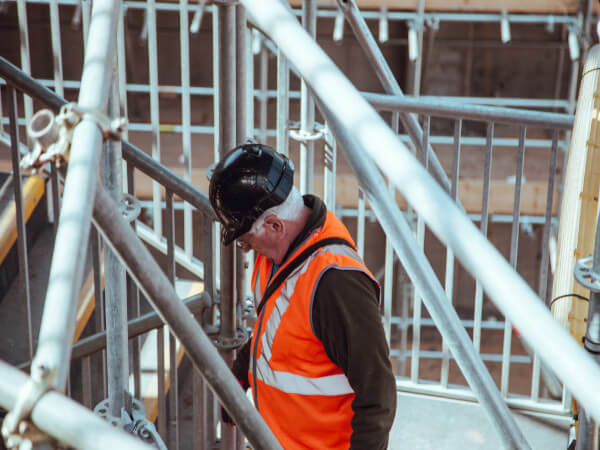
This chart shows the expected increase in flood risks by infrastructure category over the next 30 years.First Street Foundation’s “Infrastructure on the Brink” report
The report shows these four states facing the highest concentration of current risk: Louisiana, Florida, Kentucky and West Virginia. Of the top-20 at-risk counties in the U.S., 17 are in these four states.
The report also provides data on all at-risk cities and counties, and you can search on First Street’s website to find the flood risk for your property with the nonprofit’s free FloodFactor tool.
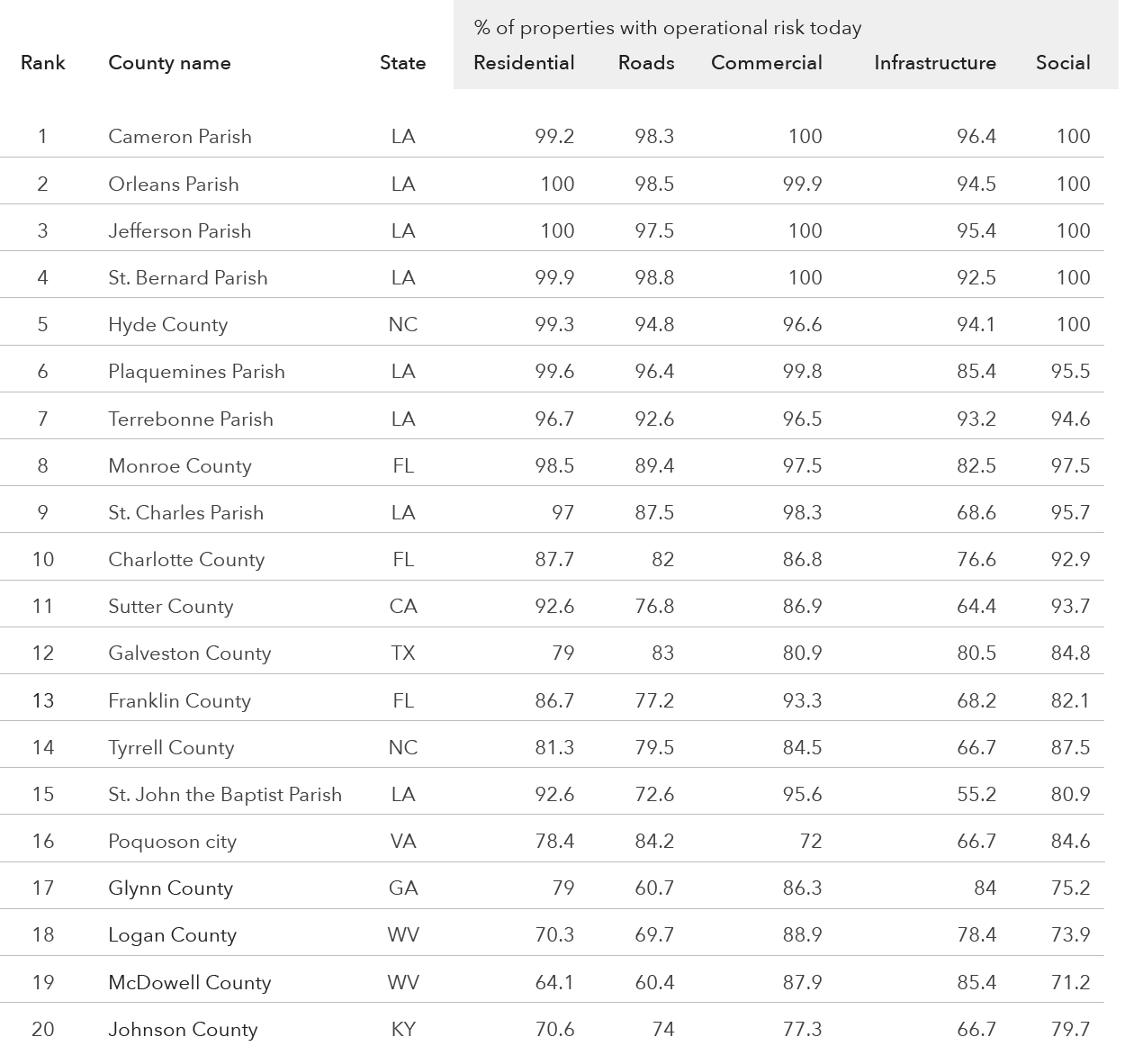
This chart shows the top-20 counties most at-risk to physical infrastructure flooding and the percentages of their infrastructure categories that are at risk. (Note: The “Infrastructure” column represents “critical infrastructure,” such as airports, fire stations, hospitals, police stations, ports, power stations.)First Street Foundation’s “Infrastructure on the Brink” report
For cities facing the most flood risk today, Moliere and New Orleans, Louisiana, top the rankings, with most, if not all, of their infrastructure vulnerable. Cities in California, South Carolina, Florida and Alabama also made the list.
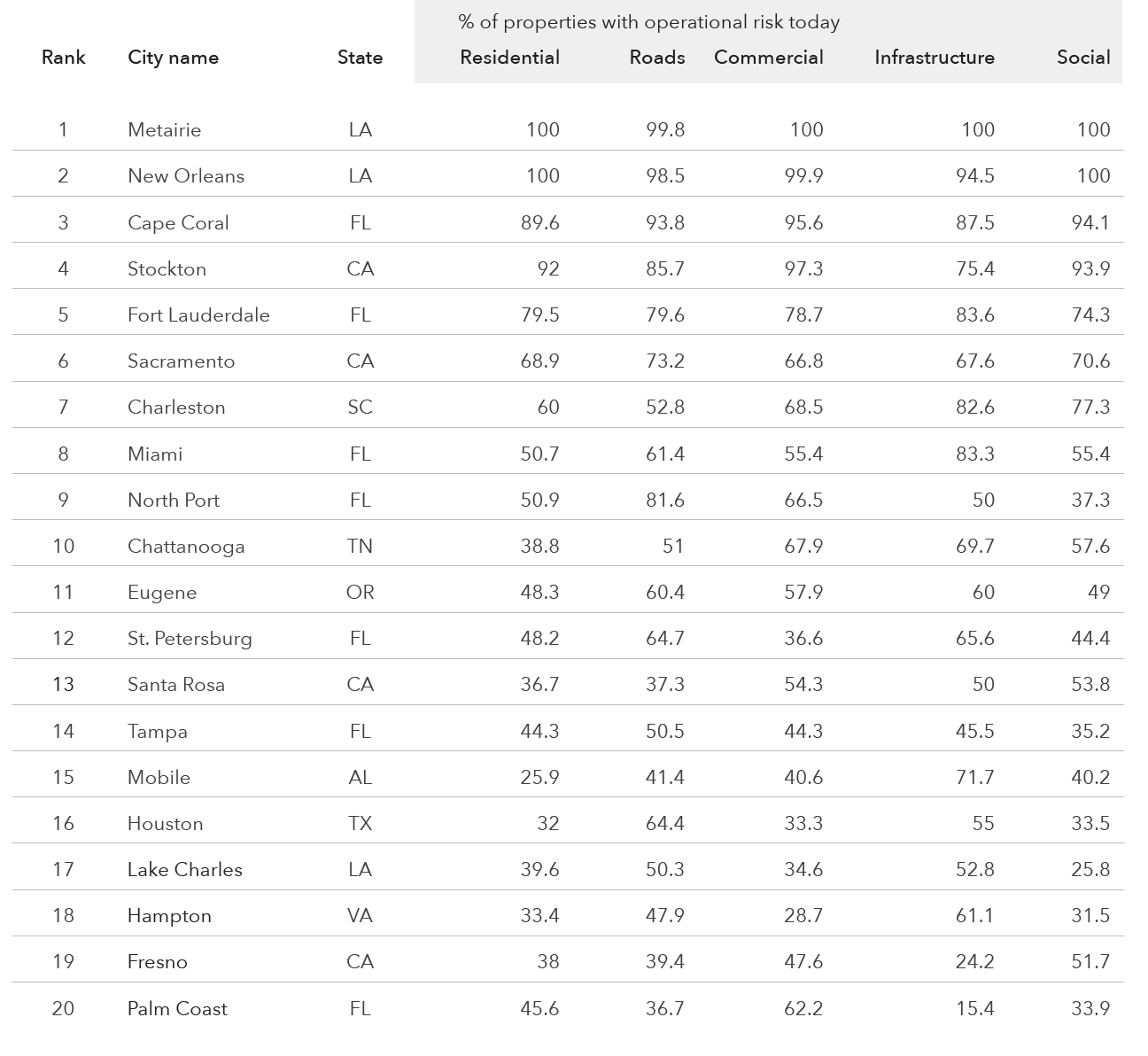
This chart shows the top-20 cities most at-risk to physical infrastructure flooding and the percentages of their infrastructure categories that are at risk. (Note: The “Infrastructure” column represents “critical infrastructure,” such as airports, fire stations, hospitals, police stations, ports, power stations.)First Street Foundation’s “Infrastructure on the Brink” report
The report also looks into the future, showing which counties will see the largest percentage increase in infrastructure risk by 2051. Virginia has several metro areas facing a significantly increased threat. The list also includes counties in North Carolina, Massachusetts, Maryland and Texas.
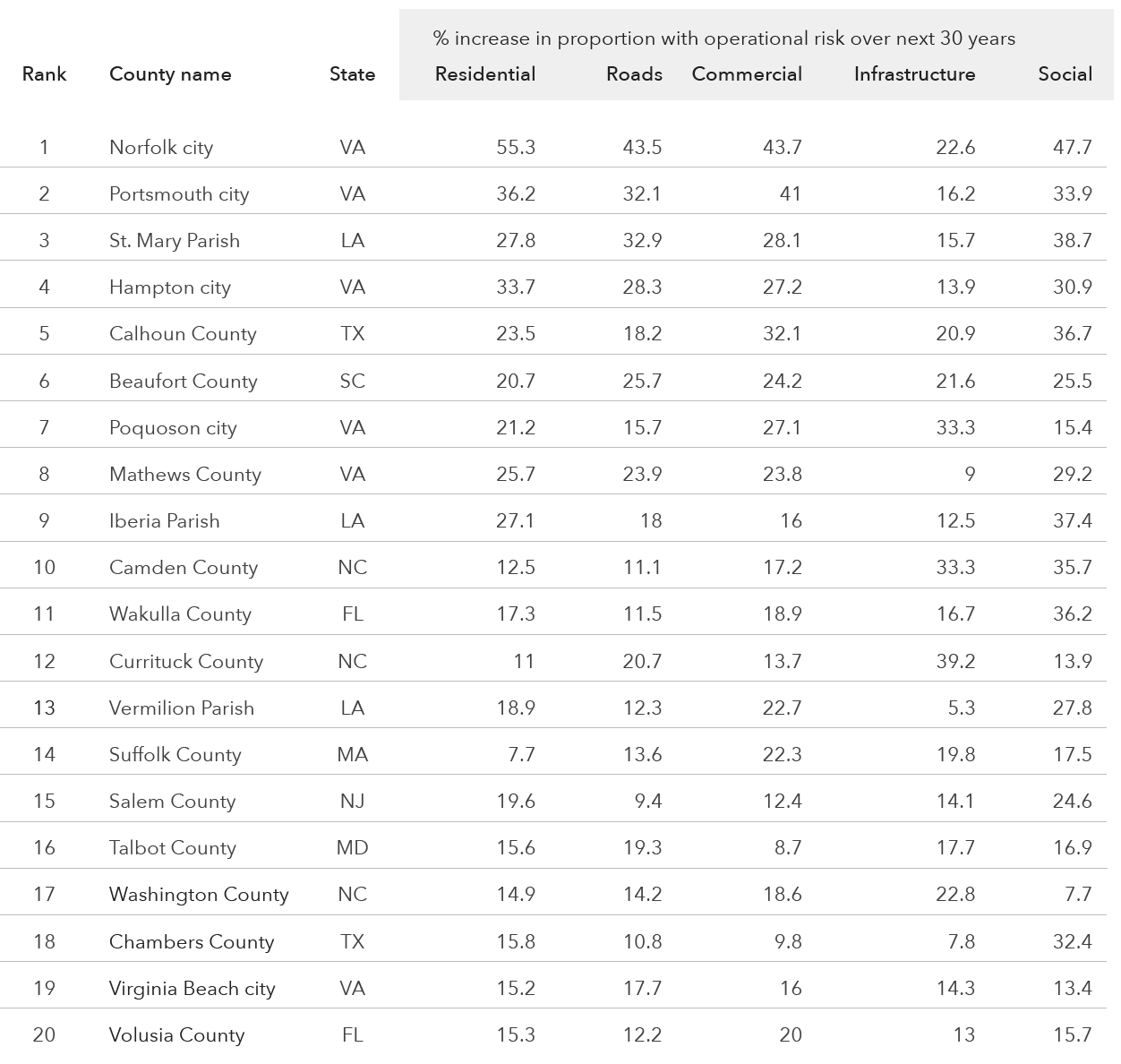
This chart shows the top-20 counties with the highest estimated percentage increase of risk to physical infrastructure flooding by 2051 and the percentages of their infrastructure categories that are at risk. (Note: The “Infrastructure” column represents “critical infrastructure,” such as airports, fire stations, hospitals, police stations, ports, power stations.)First Street Foundation’s “Infrastructure on the Brink” report
The report says the impact of the increased risks could devastate local communities. It notes that in Harris County, Texas, home to Houston, 770 hospitals, public utilities and water-treatment plants currently risk becoming inoperable due to flooding this year.
Miami-Dade, Florida, has 1,640 schools, churches and museums at risk. The Chicago metro area has 225,000 residential properties at risk. And in the New Orleans area, 99% of the roads are at risk of becoming undrivable because of flooding, the report says.
First Street Foundation hopes the data will help prioritize funding toward protecting infrastructure from flood risks.
“Our work aims to determine the amount of flooding that would render infrastructure either inoperable or inaccessible,” says Dr. Jeremy Porter of First Street Foundation. “By applying research on depth thresholds and comparing them to flood data and probability metrics, we can determine roughly the extent of flooding that would cause a road to be impassable to cars, or a hospital to be shut down.”

This map shows where the greatest flood risks are to infrastructure.First Street Foundation’s “Infrastructure on the Brink” report
Did you miss our previous article…
https://www.tortowheaton.com/?p=487
Where Do Things Stand with the Infrastructure Bill and Transportation Funding?

Since the Senate’s passage of a $1.2 trillion infrastructure bill in August, negotiations have taken a turn for the partisan worse in the House.
What once seemed to be a bipartisan effort to enact the largest spending increase for infrastructure in decades has devolved into last-ditch efforts to just keep current transportation funding levels intact – but only for one more month – and to prevent the entire federal government from shutting down, at least until December 3.
What happened?
The Infrastructure Investment & Jobs Act passed the Senate August 10 in a bipartisan 69-30 vote. It includes $550 billion in new funding over five years as well as reauthorizes increased transportation funding through 2026.
Though the bill had bipartisan support in the Senate, House Democrats wanted the bill paired with a $3.5 billion package of Biden administration initiatives called the Build Back Better Plan. The plan focuses on such measures as pre-kindergarten, paid community college tuition, expansion of Medicare and addressing climate change.
House Democrats demanded that the Senate also pass that bill before it would take up the infrastructure legislation. In a party-line vote, the Senate set up the bill for a process known as reconciliation in which it could pass by a simple majority. Democrats do not have the votes to pass the legislation under the Senate’s current rule of 60 “yes” votes to pass legislation, and it’s not likely the plan would pass with reconciliation.
When the infrastructure bill and Build Back Better Plan came to the House, Republicans and liberal Democrats balked, with most of the disagreement on the Build Back Better Plan. Scheduled votes on the infrastructure bill in September and in October were pulled as there were not enough votes to pass it.
The current schedule is for the House to vote on the infrastructure bill by October 31. President Joe Biden and House Democrats have maintained that the Build Back Better Plan must be negotiated before the infrastructure bill can pass.
Meanwhile, on October 1, federal funding for state road projects and other surface transportation expired. Thousands of federal transportation department employees were furloughed. The next day, the House and Senate passed a one-month extension of the transportation funding. The employees returned and funding resumed – but only until October 31.
While all of this was going on, the country was also running up against an October 18 deadline to raise its debt limit or face default. Senate Republicans said this was the Democrats’ responsibility, and they should extend the debt limit via the reconciliation process that would require a simple majority. Democratic senators said there was not enough time to enact reconciliation and that in the past raising the debt limit had been a bipartisan function.
On Thursday, the debt-limit crisis was temporarily averted when a compromise passed the Senate to raise the debt ceiling by $480 billion until December 3.
What’s next?
The focus in Washington now centers on the Build Back Better Plan and reducing its $3.5 trillion pricetag to one that Democrats can agree on. Biden has suggested $2 trillion, while swing-vote Senator Joe Manchin (D-W.Va.) is saying $1.5 trillion is the most he could support.
Construction industry and business groups are urging Congress to pass the infrastructure bill and separate its consideration from the Build Back Better Plan, which also includes an increase in the corporate tax rate.
“AGC is very disappointed that this historic investment in our nation’s infrastructure has yet again been delayed, and will continue calling on the House to pass the Infrastructure Investment and Jobs Act as soon as possible,” says a statement from the Associated General Contractors.
AGC says it will push the House to pass the infrastructure bill “and stop using construction companies and their workers as political leverage for the Build Back Better plan.”
“There should be no linkage between IIJA [Infrastructure Investment & Jobs Act ] and the reconciliation bill,” says the Associated Equipment Distributors. “AED will also continue to work with our industry partners in strong opposition to increasing taxes and onerous regulations on America’s job creators.”
Transportation associations are also concerned about funding for state surface transportation programs, which will again expire at the end of this month.
“Short-term extensions are not a suitable way to govern,” says Jim Tymon, president of the American Association of State Highway and Transportation Officials. “AASHTO remains focused on the passage of a long-term surface transportation bill to ensure the delivery of a safe and efficient multimodal transportation system, and we urge Congress to do the same.”
The American Road & Transportation Builders Association, along with the 32 other members of the Transportation Construction Coalition, recently wrote to Republicans and Democrats who oppose the infrastructure bill urging their reconsideration.
The letter disputes Republicans’ assertions that the bill is simply a tactic to enact the Build Back Better Plan.
“This legislation, on its own, would increase every state’s highway formula funding by an average of 35 percent,” the TCC letter says. “These significant investments will immediately begin to create new, well-paying careers and improve our nation’s roads and bridges, which will increase productivity and economic competitiveness for decades to come.”
What’s at stake?
The infrastructure bill would add $488 billion to the U.S. economy by 2027, with just the additional $153.7 billion slated for new highway, bridge and public transit investment, according to ARTBA.
Citing an analysis by IHS Markit, ARTBA says the transportation investment would also create 250,000 new jobs by 2025, with half being outside the construction industry.
An S&P Global report estimates the entire infrastructure package would create 880,000 jobs over the next decade, particularly middle-class positions in construction, engineering, transportation and energy, and would boost the overall economy by $1.4 trillion over eight years.
Here are some highlights of the additional $550 billion in spending over five years included in the infrastructure bill approved by the Senate:
Roads, bridges, major projects – $110 billionPower infrastructure – $73 billionPassenger and freight rail – $66 billionBroadband infrastructure – $65 billionDrinking water infrastructure – $55 billionPublic transit – $39 billionAirports – $25 billionPorts and waterways – $17 billionTransportation safety – $11 billionElectric vehicle infrastructure – $7.5 billionElectric buses and transit – $7.5 billionReconnecting communities split by highway projects – $1 billion
From Brooms to Blowers, 11 Attachments for Clearing Snow
Winter weather is close at hand, so it’s time to start thinking about snow-clearing equipment.
Contractors have a variety of attachments to choose from to equip their construction equipment or pickup trucks to remove snow and ice from roads, parking lots and other surfaces.
Here are 11 attachments to consider:
Bobcat’s hydraulically driven angle broom attachment (pictured above) can handle quick cleanup jobs without damaging pavement surfaces. The bristles’ waved design creates a cleaner path and can sweep more snow or debris in one pass. Reverse bristle rotation is available on the 68- and 84-inch angle brooms for sweeping leaves, snow and debris away from corners, curbs, buildings and obstacles. The standard orange heavy-duty bristles are designed for longer life and better visibility. The attachment is available for Bobcat’s M and R series compact track loaders and skid steers and Bobcat Toolcats.
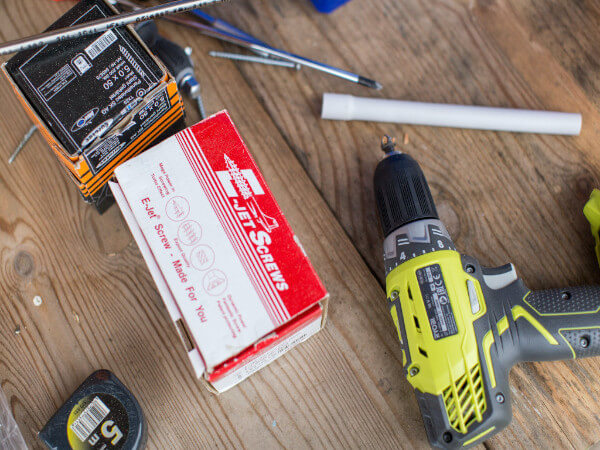
Doosan snow pusherDoosanDoosan’s bucket-mounted snow pusher attachment is designed for the company’s 13- to 20-metric-ton wheel loaders and toolcarriers. The attachment comes in two versions: 12 feet wide at 2,200 pounds and 14 feet wide at 2,400 pounds. The pusher is designed to be an alternative to buckets and traditional plowing for clearing parking lots and roads. Features include a 47-inch moldboard for high-capacity snow removal, a 1.5-inch rubber cutting edge to protect surfaces, high-grade steel skid shoes, a 12-inch push beam and three bucket-mount support tubes to help keep the snow pusher rigid.
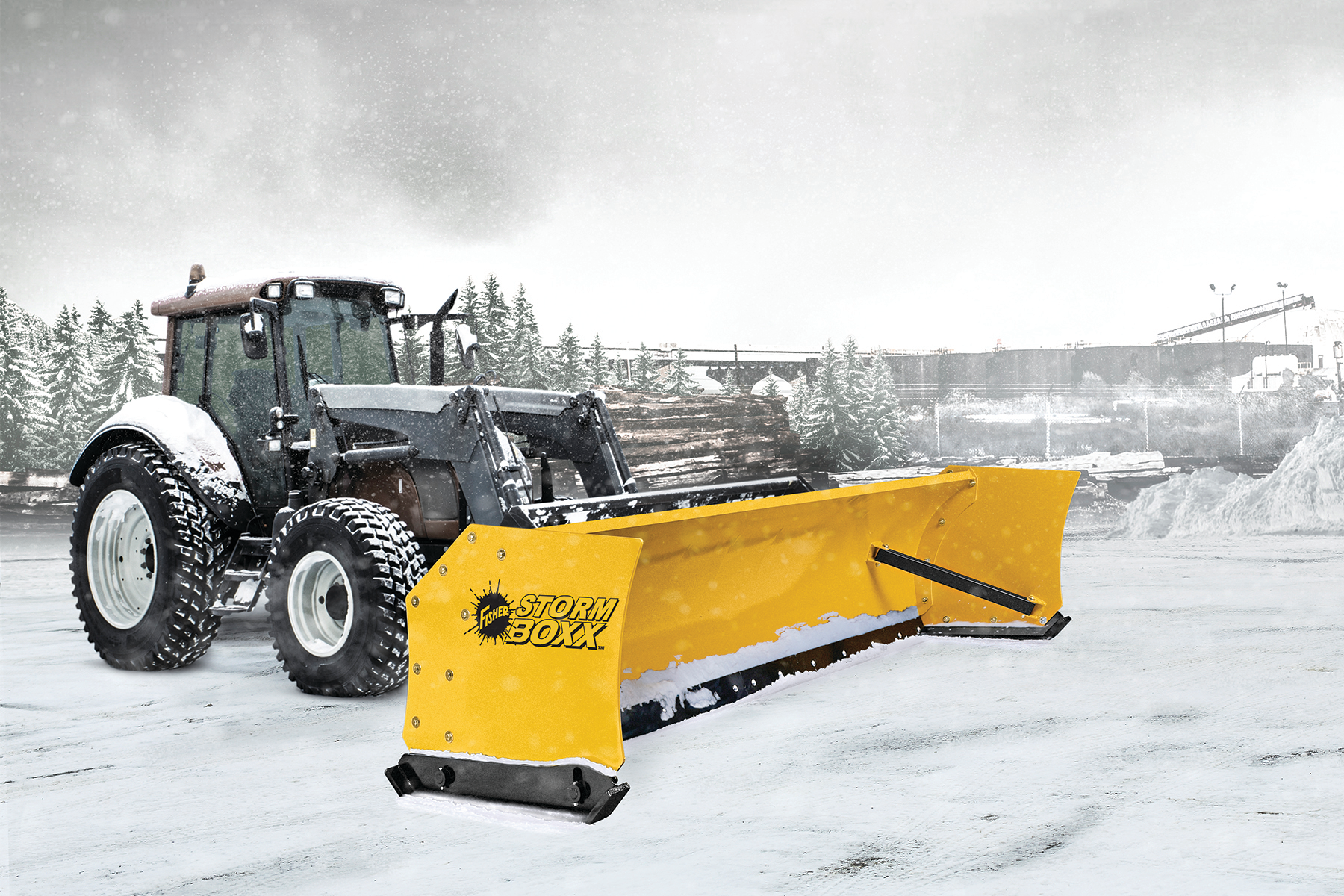
Fisher Storm Boxx snow pusherFisherFisher made its Storm Boxx pusher plows for large construction equipment, such as wheel loaders and backhoes. Models are available at 12, 14 or 16 feet wide. A two-piece steel trip edge is designed to deliver a cleaner scrape of hardpacked snow and ice. It also protects the operator and equipment when hitting hidden obstacles. Floating attachment plates allow side-to-side movement and smooth out bumps, keeping the pusher in continuous contact with the surface. It is also designed to be easily attached to various equipment.
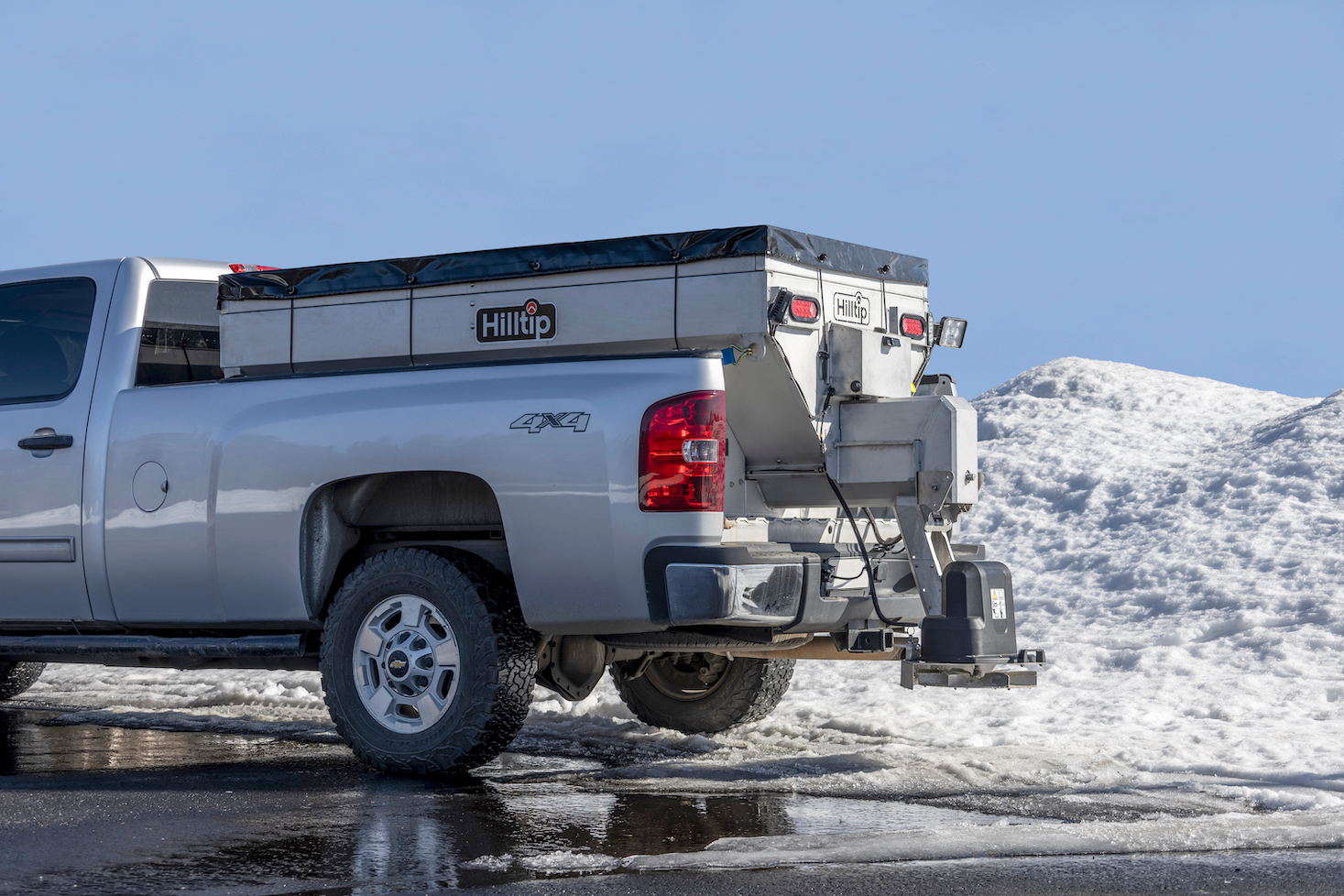
Hilltip salt spreaderHilltipHilltip’s new IceStriker 2000-3300 SSA/SSC stainless-steel salt spreaders are designed for three-quarter-ton trucks. The device can spread bulk sand and gravel, bulk/bag salt, sand-salt mixes and fertilizers. It is offered in three sizes: 2, 2.65 and 3.3 cubic yards. The stainless steel wards off corrosion, and Hilltip also immerses its hoppers in an acid bath to ensure corrosion-free welds and surfaces. An inverted “V” with a vibrator helps prevent bridging. The stainless-steel flip-up chute is designed to spread salt in environments with high humidity, and a tarp kit helps keep spreading materials dry.
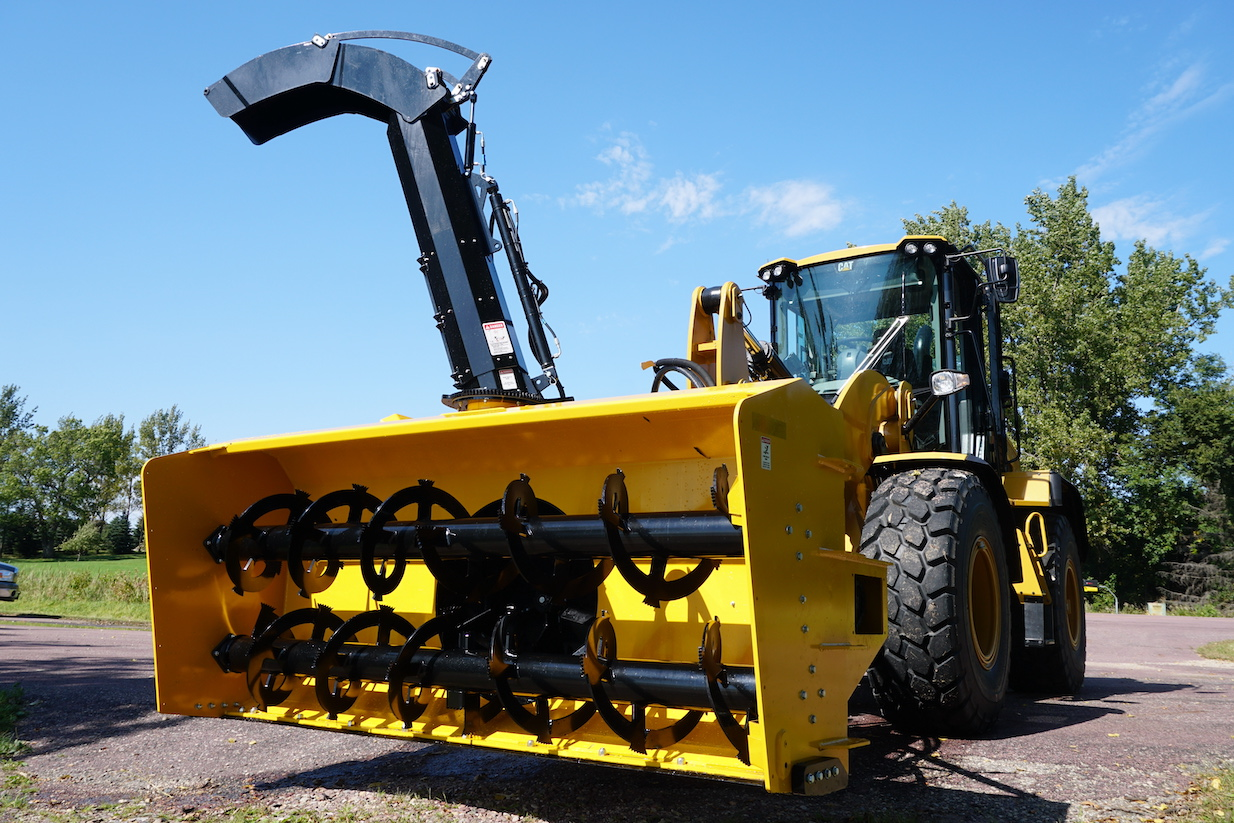
HitchDoc hydraulic snow blowerHitchDocHitchDoc’s all hydraulic snow blower is designed to reduce your carbon footprint. The company has eliminated the diesel engine, crankcase, shear pin and air filter, as well as the need for diesel exhaust fluid. The hydraulic blower is quieter and offers better visibility and balance. It is 9 feet wide and weighs 5,200 pounds. It is designed for wheel loaders of 2 to 4 cubic yards equipped with hydrostatic transmissions.
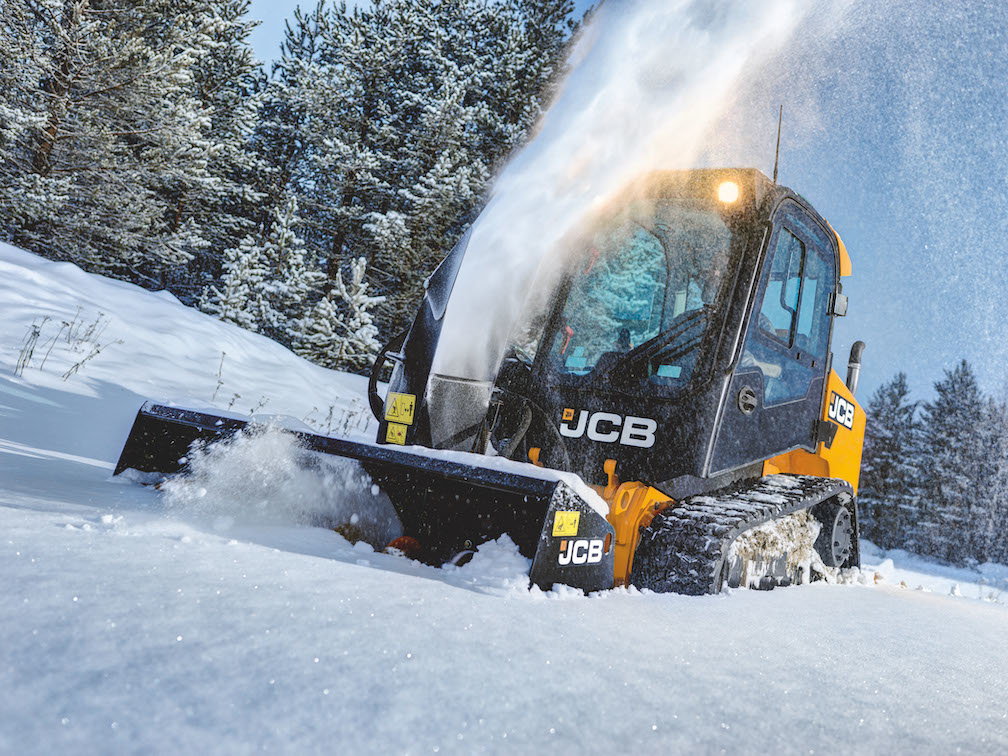
JCB Snow BlowerJCBThe JCB snow blower range features a two-stage design with the ability to throw snow 25 to 40 feet. A poly-lined chute and deflector can be adjusted to direct the snow discharge. The 25-inch standard flow shroud openings quickly dispense with high volumes of snow. The direct drive hydraulic motor design reduces the number of moving components for less wear and longer life. The blower includes adjustable skid shoes, a bolt-on replaceable wear-resistant tapered steel edge and quick release coupling. It is available in widths of 60, 72, 78 and 84 inches in either standard or high flow.
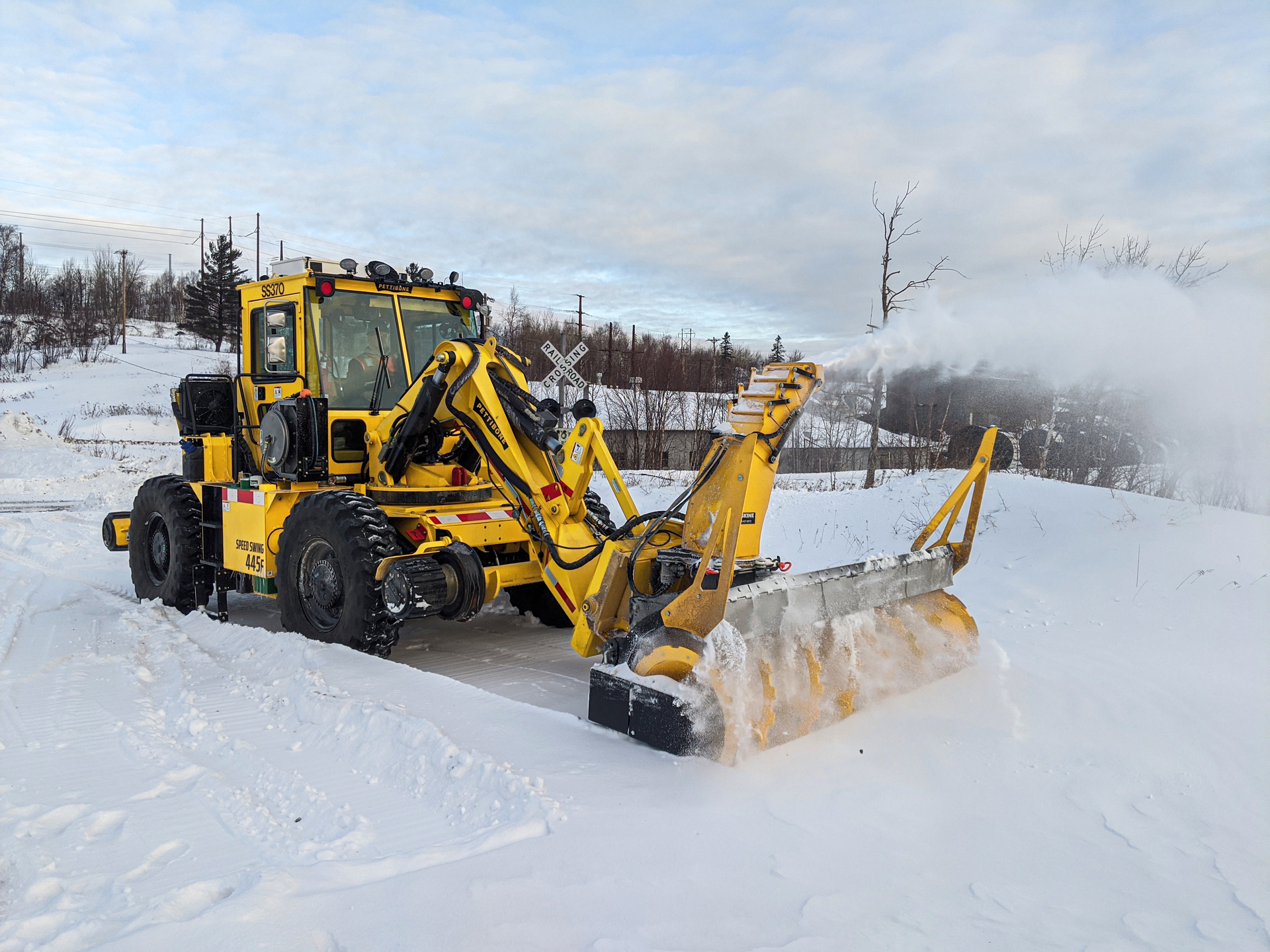
Pettibone SpeedSwing 445F with snowblowerPettibonePettibone’s Speed Swing 445F rail crane is now available with a CreepDrive system from Poclain Hydraulics that allows it to run high-flow attachments like snow blowers and power brooms at slower travel speeds on or off the rails. The CreepDrive can deliver up to 33 gallons per minute of hydraulic flow. It comes with a display interface for controlling rpms and an integrated rocker pedal for traveling the machine forward and in reverse up to 2 mph. The Speed Swing 445F provides 180-degree boom rotation and has a spacious, climate-controlled operator cab.
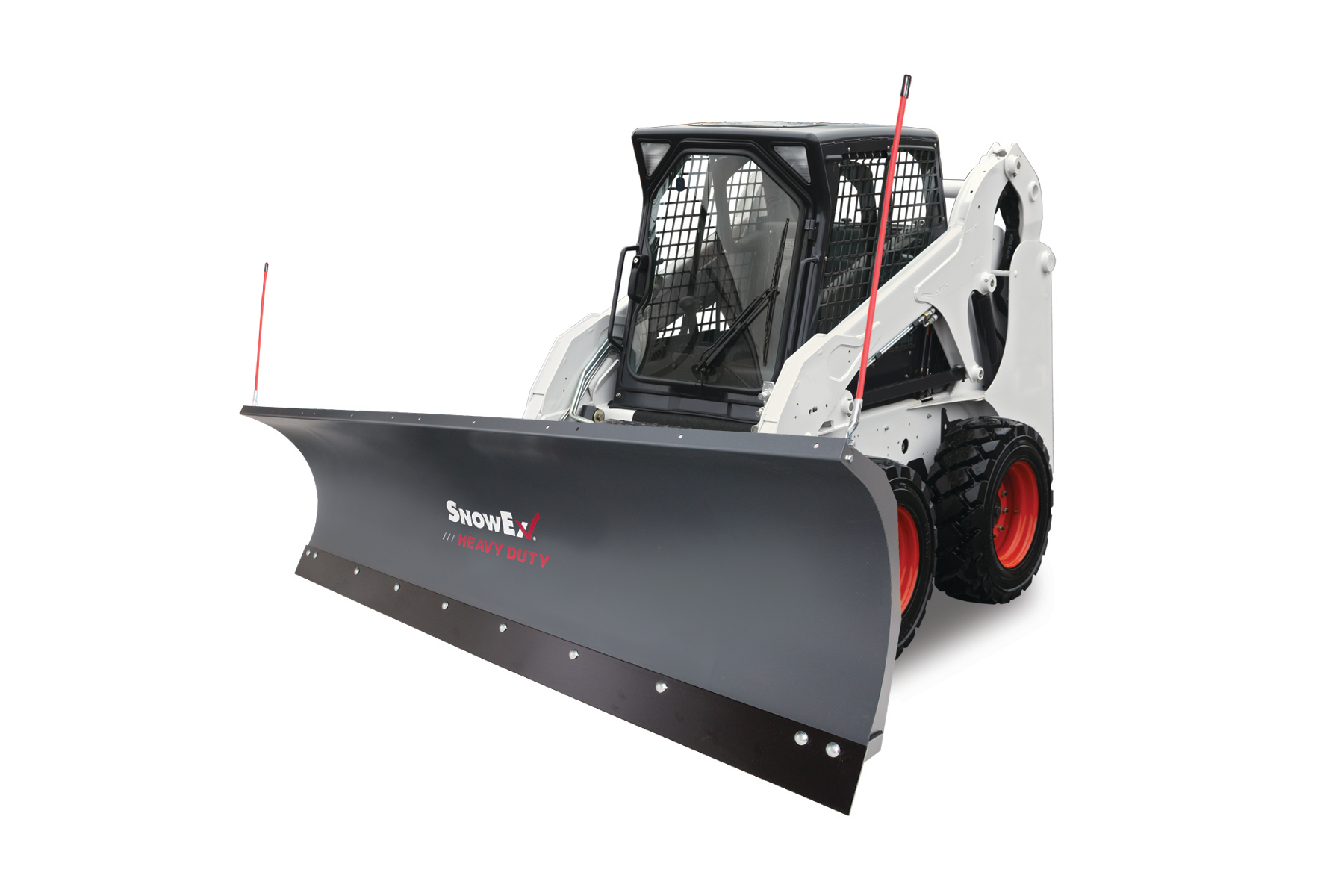
SnowEx heavy-duty snowplowSnowExSnowEx’s heavy-duty straight-blade snowplow gives skid steers commercial-contractor performance. It is available in four blade widths. The plow is built with a formed base channel for extra durability. Six vertical ribs, two angled Power Ribs and a quad design provide added torsional strength to prevent blade twisting. The A-frame is constructed of tubular steel to handle the toughest jobs.
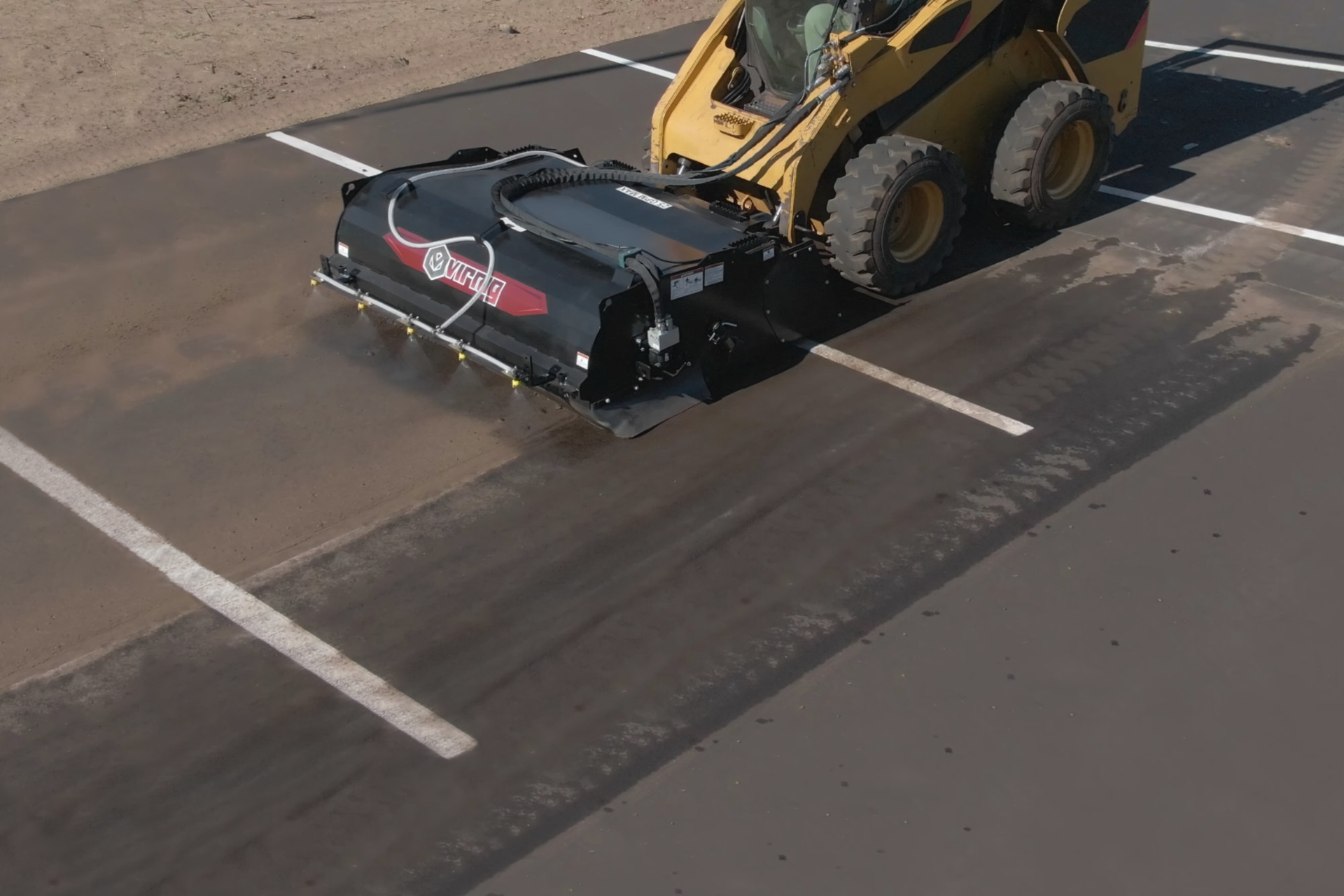
Virnig picukp broom with water tankVirnigVirnig’s Internal Water Tank Broom for skid steers controls dust as you sweep. The protected 55-gallon tank behind the bucket provides 35 minutes of continuous runtime. The translucent tank has capacity indicators so water level can be viewed by the operator while in the cab. The guarded adjustable valve regulates water pressure to the nozzles. The broom is available in 72 or 84 inches. Features on the broom include a recessed and guarded direct drive motor, HD bucket with wear bars, bolt-on edge, oversized 2-inch bearing, poly/wire bristles and pin adjustment system.
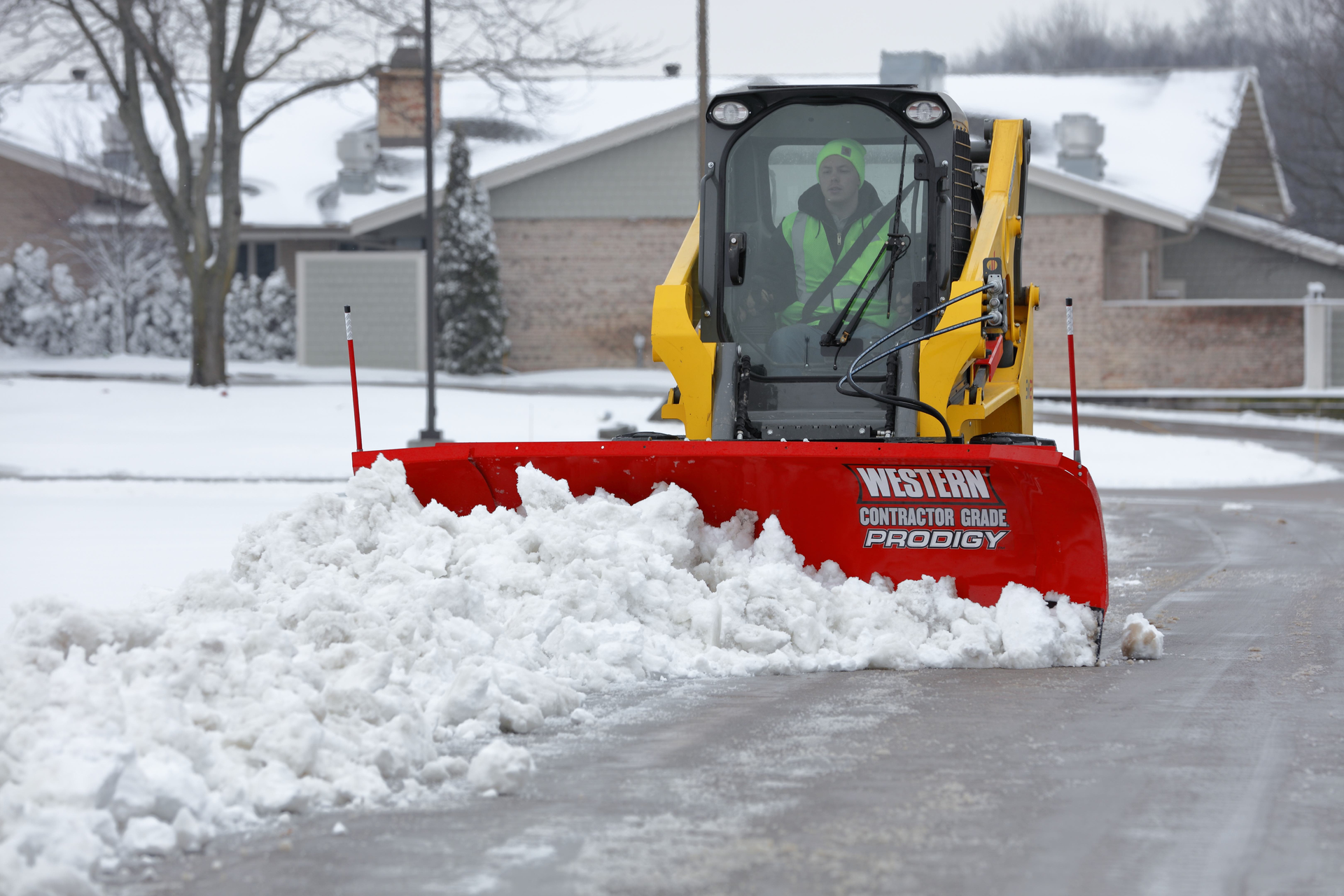
Western’s Prodigy Skid Steer SnowplowWesternThe Prodigy snowplow from Western features wings that automatically move with no additional wiring or controls. It has a universal skid-steer mounting plate. Once the pins are engaged, the plow is ready. The plow uses the onboard hydraulics system of the skid steer to lift and lower the blade. An oscillating mount that provides 6 degrees of total side-to-side oscillation is optional to improve scrape and cutting-edge wear while reducing damage to the terrain.
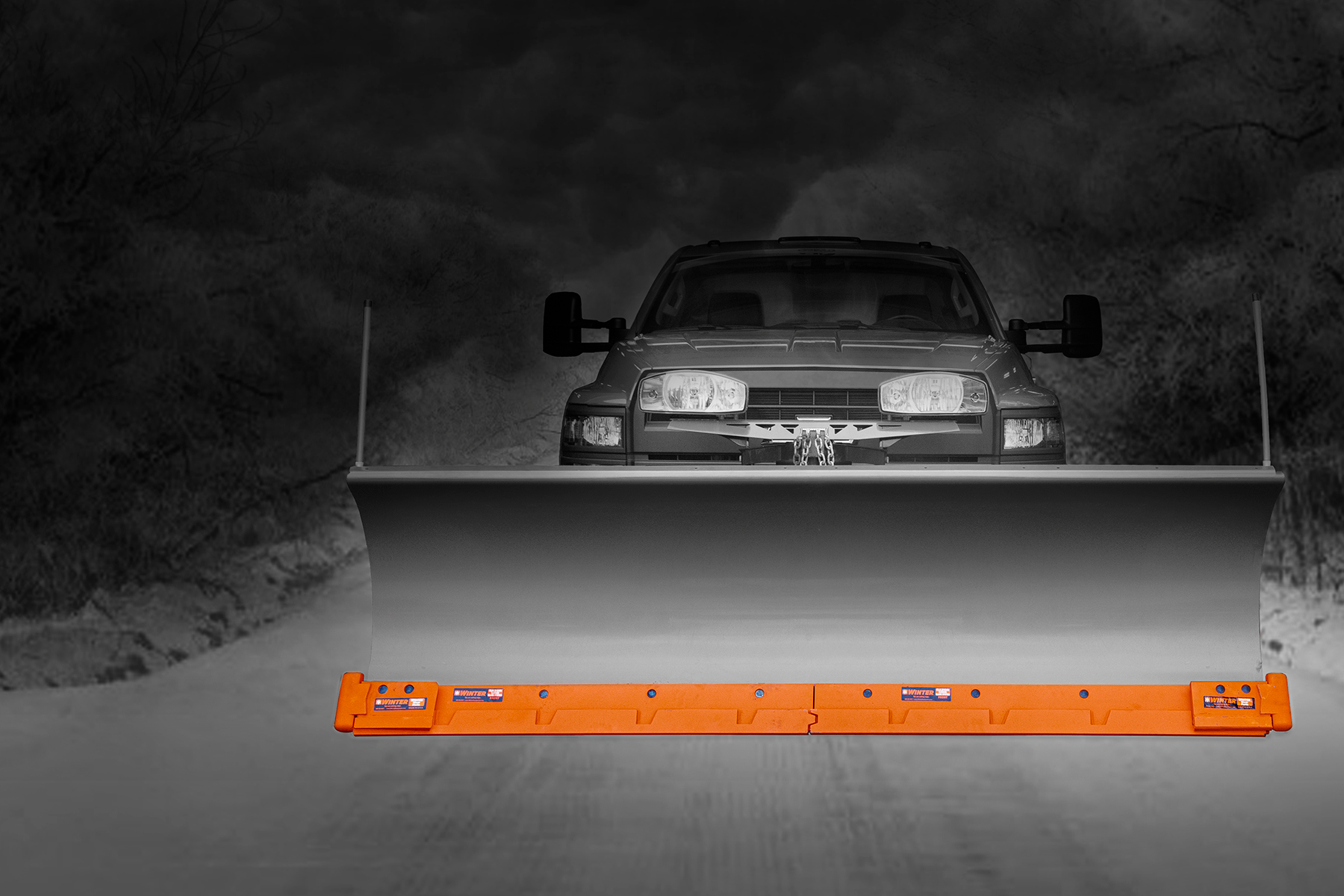
Winter Equipment Razor Arrow snow bladeWinter EquipmentWinter Equipment’s Razor Arrow Straight Blade System is designed to give Western Pro Plus plows longer blade life and improve cutting. It features two, 4-1/2-foot Razor blade sections, two Plow Guard Juniors and grade 8 hardware. The two Plow Guard Juniors prevent uneven and premature wear on the plow’s wear bar. The Razor Arrow system includes a two-piece, pre-welded blade with 5/8-inch abrasion-resistant cover plates. The cover plates are welded to a tungsten carbide insert cutting edge for increased wear life and surface footprint. Built-in wear indicators help to track wear life.
Did you miss our previous article…
https://www.tortowheaton.com/?p=425